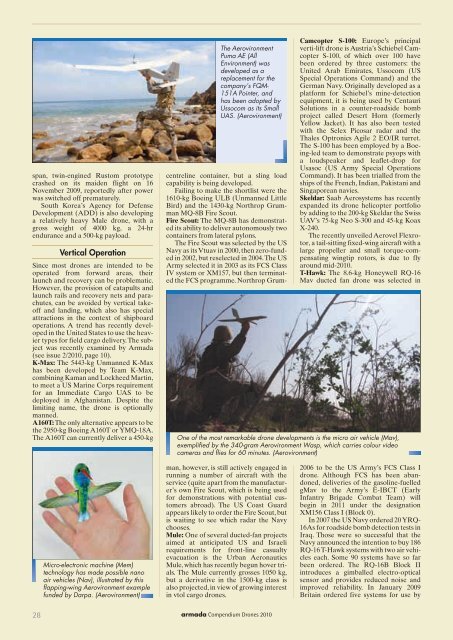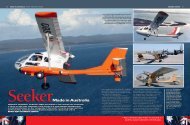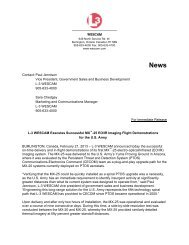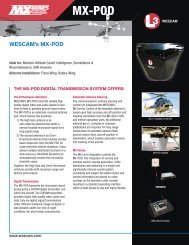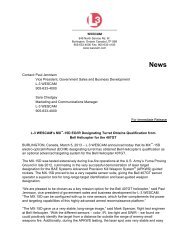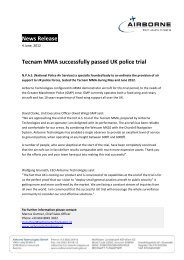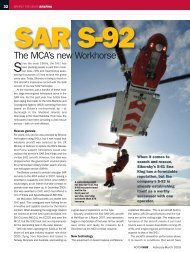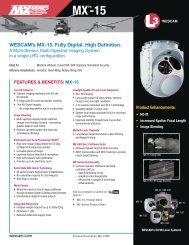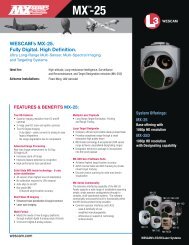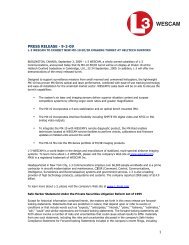Sensors - Wescam
Sensors - Wescam
Sensors - Wescam
Create successful ePaper yourself
Turn your PDF publications into a flip-book with our unique Google optimized e-Paper software.
span, twin-engined Rustom prototype<br />
crashed on its maiden flight on 16<br />
November 2009, reportedly after power<br />
was switched off prematurely.<br />
South Korea’s Agency for Defense<br />
Development (ADD) is also developing<br />
a relatively heavy Male drone, with a<br />
gross weight of 4000 kg, a 24-hr<br />
endurance and a 500-kg payload.<br />
Vertical Operation<br />
Since most drones are intended to be<br />
operated from forward areas, their<br />
launch and recovery can be problematic.<br />
However, the provision of catapults and<br />
launch rails and recovery nets and parachutes,<br />
can be avoided by vertical takeoff<br />
and landing, which also has special<br />
attractions in the context of shipboard<br />
operations. A trend has recently developed<br />
in the United States to use the heavier<br />
types for field cargo delivery. The subject<br />
was recently examined by Armada<br />
(see issue 2/2010, page 10).<br />
K-Max: The 5443-kg Unmanned K-Max<br />
has been developed by Team K-Max,<br />
combining Kaman and Lockheed Martin,<br />
to meet a US Marine Corps requirement<br />
for an Immediate Cargo UAS to be<br />
deployed in Afghanistan. Despite the<br />
limiting name, the drone is optionally<br />
manned.<br />
A160T: The only alternative appears to be<br />
the 2950-kg Boeing A160T or YMQ-18A.<br />
The A160T can currently deliver a 450-kg<br />
The Aerovironment<br />
Puma AE (All<br />
Environment) was<br />
developed as a<br />
replacement for the<br />
company’s FQM-<br />
151A Pointer, and<br />
has been adopted by<br />
Ussocom as its Small<br />
UAS. (Aerovironment)<br />
centreline container, but a sling load<br />
capability is being developed.<br />
Failing to make the shortlist were the<br />
1610-kg Boeing ULB (Unmanned Little<br />
Bird) and the 1430-kg Northrop Grumman<br />
MQ-8B Fire Scout.<br />
Fire Scout: The MQ-8B has demonstrated<br />
its ability to deliver autonomously two<br />
containers from lateral pylons.<br />
The Fire Scout was selected by the US<br />
Navy as its Vtuav in 2000, then zero-funded<br />
in 2002, but reselected in 2004. The US<br />
Army selected it in 2003 as its FCS Class<br />
IV system or XM157, but then terminated<br />
the FCS programme. Northrop Grum-<br />
Camcopter S-100: Europe’s principal<br />
verti-lift drone is Austria’s Schiebel Camcopter<br />
S-100, of which over 100 have<br />
been ordered by three customers: the<br />
United Arab Emirates, Ussocom (US<br />
Special Operations Command) and the<br />
German Navy. Originally developed as a<br />
platform for Schiebel’s mine-detection<br />
equipment, it is being used by Centauri<br />
Solutions in a counter-roadside bomb<br />
project called Desert Horn (formerly<br />
Yellow Jacket). It has also been tested<br />
with the Selex Picosar radar and the<br />
Thales Optronics Agile 2 EO/IR turret.<br />
The S-100 has been employed by a Boeing-led<br />
team to demonstrate psyops with<br />
a loudspeaker and leaflet-drop for<br />
Usasoc (US Army Special Operations<br />
Command). It has been trialled from the<br />
ships of the French, Indian, Pakistani and<br />
Singaporean navies.<br />
Skeldar: Saab Aerosystems has recently<br />
expanded its drone helicopter portfolio<br />
by adding to the 200-kg Skeldar the Swiss<br />
UAV’s 75-kg Neo S-300 and 45-kg Koax<br />
X-240.<br />
The recently unveiled Aerovel Flexrotor,<br />
a tail-sitting fixed-wing aircraft with a<br />
large propeller and small torque-compensating<br />
wingtip rotors, is due to fly<br />
around mid-2010.<br />
T-Hawk: The 8.6-kg Honeywell RQ-16<br />
Mav ducted fan drone was selected in<br />
One of the most remarkable drone developments is the micro air vehicle (Mav),<br />
exemplified by the 340-gram Aerovironment Wasp, which carries colour video<br />
cameras and flies for 60 minutes. (Aerovironment)<br />
Micro-electronic machine (Mem)<br />
technology has made possible nano<br />
air vehicles (Nav), illustrated by this<br />
flapping-wing Aerovironment example<br />
funded by Darpa. (Aerovironment)<br />
man, however, is still actively engaged in<br />
running a number of aircraft with the<br />
service (quite apart from the manufacturer’s<br />
own Fire Scout, which is being used<br />
for demonstrations with potential customers<br />
abroad). The US Coast Guard<br />
appears likely to order the Fire Scout, but<br />
is waiting to see which radar the Navy<br />
chooses.<br />
Mule: One of several ducted-fan projects<br />
aimed at anticipated US and Israeli<br />
requirements for front-line casualty<br />
evacuation is the Urban Aeronautics<br />
Mule, which has recently begun hover trials.<br />
The Mule currently grosses 1050 kg,<br />
but a derivative in the 1500-kg class is<br />
also projected, in view of growing interest<br />
in vtol cargo drones.<br />
2006 to be the US Army’s FCS Class I<br />
drone. Although FCS has been abandoned,<br />
deliveries of the gasoline-fuelled<br />
gMav to the Army’s E-IBCT (Early<br />
Infantry Brigade Combat Team) will<br />
begin in 2011 under the designation<br />
XM156 Class I (Block 0).<br />
In 2007 the US Navy ordered 20 YRQ-<br />
16As for roadside bomb detection tests in<br />
Iraq. Those were so successful that the<br />
Navy announced the intention to buy 186<br />
RQ-16 T-Hawk systems with two air vehicles<br />
each. Some 90 systems have so far<br />
been ordered. The RQ-16B Block II<br />
introduces a gimballed electro-optical<br />
sensor and provides reduced noise and<br />
improved reliability. In January 2009<br />
Britain ordered five systems for use by<br />
28 armada Compendium Drones 2010


